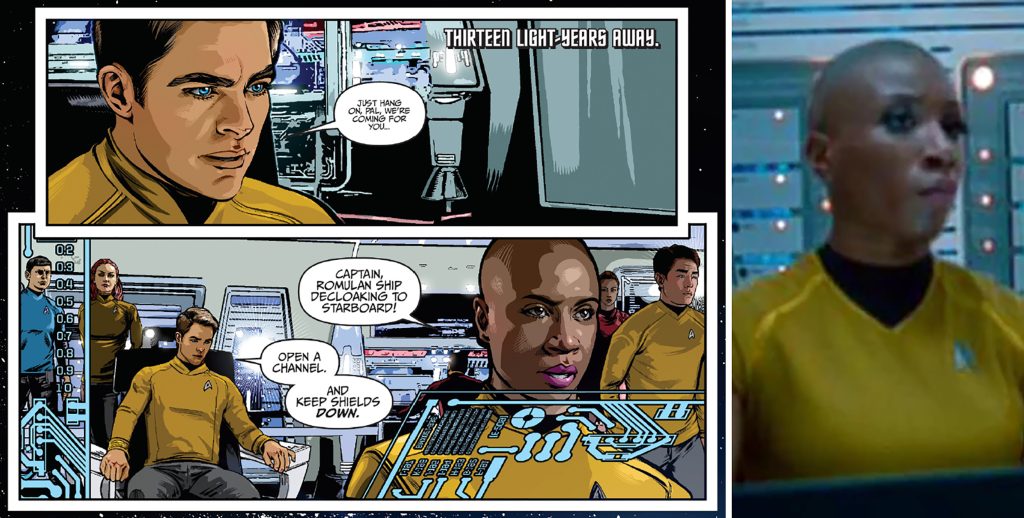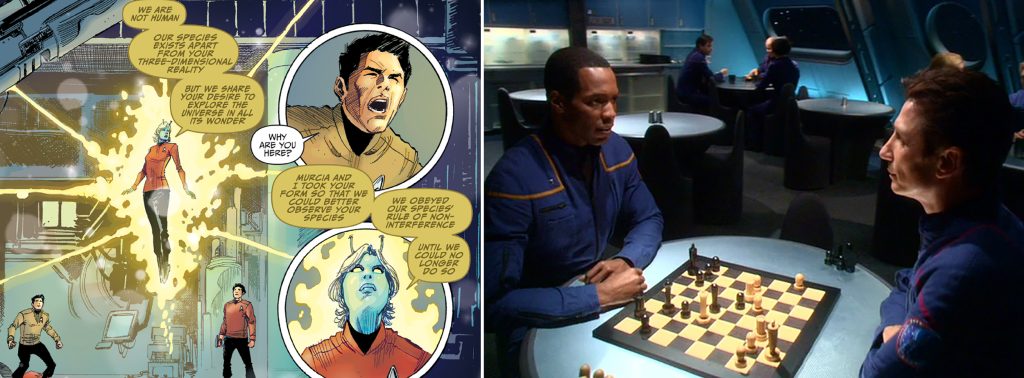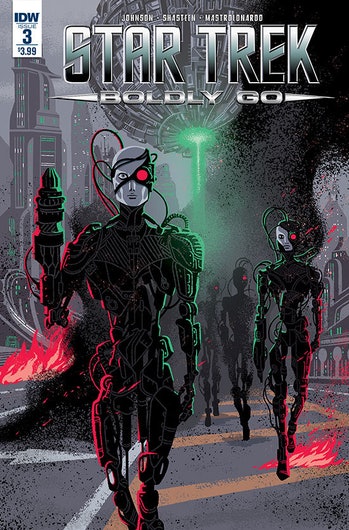An ongoing discussion of how the comics provide prequels, sequels, and tie-ins to the Star Trek episodes and films, soon to be a book from BearManor Media. Click here to view an archive of this article series.
121: IDW Publishing, 2016–2017
Nero’s incursion in the 2009 Star Trek film resulted in a parallel reality fundamentally altered from the prime one. Some changes were noticeable yet relatively minor, such as Pavel Chekov being a bit younger, Montgomery Scott working alongside Keenser, Klingon warriors wearing helmets and cranial rings, and Carol Marcus being British and, er, a bombshell trained to work with actual bombshells. But others were far more impactful. James T. Kirk grew up never knowing his father. Christopher Pike was killed by a white Khan Noonien Singh and didn’t end up a scarred invalid. And Starfleet was decimated by Nero’s superior vessel, resulting in Section 31 majorly upgrading the fleet’s technology beyond that seen on the 1960s TV show.

IDW’s Star Trek: Boldly Go revealed more such changes, and this week’s column examines the first six chapters. Boldly Go continued IDW’s ongoing saga set in the Kelvin timeline, which had reached its final issue two months prior. Whereas that series began in the 2009 movie’s aftermath, then continued until well after the events of Star Trek Into Darkness, Boldly Go took place following Star Trek Beyond, the third entry in J.J. Abrams’ trilogy, in which the Battle of Altamid resulted in the loss of the alternate Enterprise to Balthazar Edison, a.k.a. Krall.

Scripted by Mike Johnson and Ryan Parrott, these six issues featured interior art by Tony Shasteen and Chris Mooneyham, with covers from Shasteen, George Caltsoudas, Marc Laming, and James Kenneth Woodward. The comic was beautifully drawn, both inside and out, and it featured some of Johnson’s strongest writing during his long tenure charting the voyages of the Kelvin cast.

Spanning eighteen issues (it should have run longer!), Boldly Go offered tie-ins to various films and episodes. The series took place within Star Trek Beyond, in the time jump between Krall’s defeat and the Enterprise-A’s launch. With the new starship under construction, Kirk is given command of the USS Endeavour for a one-year survey mission, while some of his officers accept temporary postings elsewhere. This approach allowed the Kelvin-centric comics to continue without Johnson knowing what would happen next on the big screen.
If this setup sounds familiar, there’s a reason for that: DC Comics had faced a similar challenge in the lead-up to Star Trek IV: The Voyage Home, due to the Enterprise’s destruction in Star Trek III: The Search for Spock. DC had skirted the problem in the same manner, with Kirk commanding the USS Excelsior and Spock captaining his own ship, the Surak, until the crew could be reunited for Star Trek IV and the unveiling of the prime Enterprise-A. Shaking up the status quo enabled the creators to avoid conflicts with Paramount’s then-unannounced plans.

For IDW, the result was the same, with Boldly Go reinvigorating the alt-reality comics by taking the characters’ story in a new direction. Chekov and Leonard McCoy have remained with Kirk aboard the Endeavour, as have Into Darkness’s Zahra and Lieutenant Darwin. Bones has accepted a reduction in rank and now serves under a grumpy Tellarite physician named Groffus. And Romulan dissident Valas is Kirk’s first officer, with Nyota Uhura and Spock taking a leave of absence to assist the New Vulcan colonists.
Montgomery Scott teaches at Starfleet Academy, and among his students are Star Trek Beyond’s Jaylah, as well as the cadet squad from IDW’s Starfleet Academy miniseries. Hikaru Sulu, meanwhile, is now assigned to the USS Concord, and his husband and daughter, introduced in Beyond, live with him aboard that starship. Starting with issue #6, he becomes Kirk’s first officer aboard the Endeavour.

Issues #1–4 revealed one of the most profound changes resulting from Nero’s incursion, as they featured the Kelvin timeline’s Borg Collective, who’d detected the Narada’s arrival on the day of Kirk’s birth and have spent thirty years seeking out what they call “the outlier”—a Borg ship not under their control. As revealed in IDW’s Star Trek: Countdown, Nero’s vessel had once been an ordinary mining ship, but following his world’s destruction, he’d visited a secret military base to have the Narada fitted with salvaged Borg tech so he could seek revenge. Apparently, the Borg noticed this.
This represents an enormous change in the timeline, compounded by the Borg invading outposts along the Romulan Neutral Zone and then attacking Romulus itself. All of this occurs a century before the prime Federation has first contact with the Collective in The Next Generation’s “Q Who” (the events of Star Trek: First Contact, Voyager’s “Dark Frontier,” and Enterprise’s “Regeneration” notwithstanding). It’s also a hundred years before the prime Borg destroy the Romulan outposts in The Next Generation’s “The Neutral Zone.” The differences that would result from this are incalculable.
What’s interesting is that this is not the first time comics have shown James T. Kirk encountering the Borg. Tokyopop’s Star Trek—The Manga had prime Kirk meet the Borg Queen, while Star Trek: New Visions saw the Enterprise fight a Borg sphere, though in neither instance did Jim discover the Borg’s identity, neatly avoiding contradictions with “Q Who.” Boldly Go ups the ante by having his crew learn of the Collective’s existence in the Abramsverse, with the Borg remaining a deadly threat in the 23rd century.

The Concord is captained by Clark Terrell, whose prime counterpart commanded the Reliant in Star Trek II: The Wrath of Khan. Sulu is his first officer, mirroring Chekov’s reassignment to the Reliant onscreen. The Borg’s assimilation of Terrell provides a clever callback to The Next Generation’s “The Best of Both Worlds,” as Spock neck-pinches him and commands him to “sleep,” the same command the Enterprise-D crew used to liberate Jean-Luc Picard from the cyborgs.

Terrell can’t catch a break—he’s controlled by Ceti eels in one reality and by Borg in another. (If he has a mirror counterpart, that Terrell probably ends up possessed by Redjac and Beverly Crusher’s sex candle.) Spock is assimilated as well, but his hybrid DNA enables him to resist (of course it does—this is Spock). The Collective thus stimulate and alter his memories of the 2009 movie, with his father Sarek and other characters appearing as Borg, in an effort to break through his defenses.

On New Vulcan, Uhura sports the same outfit and hairstyle that T’Pring, Spock’s betrothed in the prime timeline, had worn in The Original Series’ “Amok Time.” As it happens, the actual T’Pring in the Kelvin timeline had already appeared in Johnson’s ongoing title, with a very different look.

Then there’s Jaylah, Beyond’s best new addition to the franchise. Issue #5 replays the events of her pre-movie life, when she grew up on a space-trading vessel before being stranded on Altamid. The one-shot, told in backward chronological order from the present to her birth, explores her mother’s fatal illness, her family’s capture by Krall, the murders of her father and her sister Keelah by Anderson Le (Beyond’s Manas), her discovery of the USS Franklin, and finally her joining Starfleet Academy. It’s a powerful tie-in, reinforcing why viewers embraced Sofia Boutella’s Jaylah and what a shame it is that a fourth film didn’t materialize with the character replacing the late Anton Yelchin.

Finally, issue #6 flips the script on the Prime Directive, with two benevolent aliens posing as Starfleet officers to explore the universe with Kirk’s crew. Their noncorporeal species maintains a non-interference directive, and they act as observers without affecting the crew’s lives—until a white hole threatens the ship, forcing them to reveal their nature. Could they be from Organia (“Errand of Mercy”), given Enterprise’s “Observer Effect,” in which Organians posed as Travis Mayweather and Malcolm Reed to observe Jonathan Archer’s crew, then intervened during a crisis? The parallels may not be coincidental, given Johnson’s fondness for retelling classic tales with a Kelvin twist.

Next week’s installment will examine comics that aren’t Star Trek but merit discussion anyway due to their connection to the franchise. After that, we’ll continue dissecting both New Visions and Boldly Go. And then? Two words: “mirror universe.”
Looking for more information about Star Trek comics? Check out these resources:
- My ongoing column for Titan Books’ Star Trek Explorer magazine
- The Complete Star Trek Comics Index, curated by yours truly
- The Star Trek Comics Checklist, by Mark Martinez
- The Wixiban Star Trek Collectables Portal, by Colin Merry
- New Life and New Civilizations: Exploring Star Trek Comics, by Joseph F. Berenato (Sequart, 2014)
- Star Trek: A Comics History, by Alan J. Porter (Hermes Press, 2009)
- The Star Trek Comics Weekly page on Facebook
Rich Handley has written, co-written, co-edited, or contributed to dozens of books, both fiction and non-fiction, about Planet of the Apes, Watchmen, Back to the Future, Star Trek, Star Wars, Battlestar Galactica, Hellblazer, Swamp Thing, Stargate, Dark Shadows, The X-Files, Twin Peaks, Red Dwarf, Blade Runner, Doctor Who, Buffy the Vampire Slayer, Batman, the Joker, classic monsters, and more. He has also been a magazine writer and editor for nearly three decades. Rich edited Eaglemoss’s Star Trek Graphic Novel Collection, and he currently writes articles for Titan’s Star Trek Explorer magazine, as well as books for an as-yet-unannounced role-playing game. Learn more about Rich and his work at richhandley.com.

One thought on “Star Trek Comics Weekly #121”